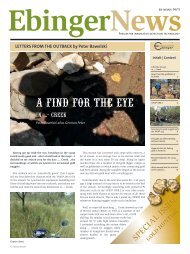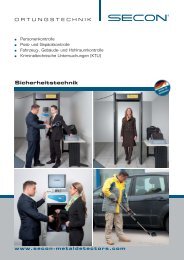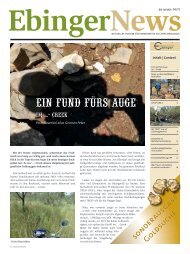unterwasser-metalldetektoren uwex® erobern den tauchsport - Secon
unterwasser-metalldetektoren uwex® erobern den tauchsport - Secon
unterwasser-metalldetektoren uwex® erobern den tauchsport - Secon
Erfolgreiche ePaper selbst erstellen
Machen Sie aus Ihren PDF Publikationen ein blätterbares Flipbook mit unserer einzigartigen Google optimierten e-Paper Software.
occur when – as a result of magnetic rock, stronger<br />
than usual remanent magnetism and/or the fact that<br />
an unexploded ordnance device is located unfavourably<br />
– the latter cannot be detected by purely magnetic<br />
detection methods so that active electromagnetic probing<br />
represents an appropriate alternative.<br />
These interrelationships are also made clear taking<br />
as an example again the survey of the landfill. Fig. 5<br />
shows on the left the result of the frequency electromagnetism<br />
survey with the twin coil frequency electromagnetism<br />
device shown in Fig. 2 over a central part of<br />
the landfill and – on the right – the data from the magnetic<br />
field survey of the same area. It is easy to see that<br />
numerous FEM-detected anomalies correspond with<br />
magnetically-detected anomalies and thus are likely to<br />
represent ferrous metal bodies. However there are also<br />
significant differences and the electromagnetic signature<br />
is overall clearer than the magnetic one. This results<br />
from the very different measurement parameters<br />
(magnetization and electrical conductivity) and could<br />
be interpreted in the sense of differentiation between<br />
materials.<br />
The perhaps most impressive images from the geophysical<br />
survey of the landfill are those obtained with the<br />
transient or pulsed electromagnetic method (TEM, Fig. 6).<br />
However this method is also the most expensive one<br />
in terms of equipment. For better understanding but<br />
expressed in very simplified terms one can say that<br />
the electromagnetic signal transmitted with the pulses<br />
Abb. 6. Aktive Impulssondierung (TEM) in drei ausgewählten Zeit-<br />
fenstern mit der oberen Schleife im Array der Abb. 4. Fläche<br />
wie in Abb. 5. Das Messsystem erlaubt die Registrierung in<br />
insgesamt sechs Zeitfenstern synchron in bei<strong>den</strong> Schleifen<br />
(unten, schematisch).<br />
Fig. 6. Active pulsed probing (TEM) in three selected time frames with<br />
the upper loop shown in the array in Fig. 4. The area surveyed is<br />
the same as the one surveyed in Fig. 5. The measuring system<br />
permits registering in a total of six time frames synchronously<br />
in both loops (at the bottom, schematically).<br />
wanders downwards (and also laterally) with time so that it gives its „answer“ in the<br />
form of a signal to the reception coil in a continuous manner. Thus in a certain way<br />
the substrate is imaged in respect of a time period of the order of microseconds and<br />
milliseconds. The measurements at two different distances above the surface of the<br />
ground mean that surface factors of influence and deeper areas can be addressed<br />
and the differentiation between the signals from the upper and lower loops (similar<br />
to the differentiation with the Fluxgate gradiometers) comes close to the so-called<br />
vertical gradient which is characterized by a higher resolution. The selection shown<br />
here for just three channels (Fig. 6) makes very clear how much the field structure<br />
changes in successive time frames.<br />
Time-bombs: The problem of historic wastes, that is becoming ever more urgent,<br />
forced geophysicists 20 – 30 years ago to adjust their measurement systems, which<br />
up to this time had been used primarily to look down to much greater depths, to the<br />
new situations requiring investigation. Explosive ordnance disposal methods have<br />
followed this trend only in a very dilatory manner or not at all. This article is intended<br />
to indicate that different procedures are also possible.<br />
Abb. 4. Ausschnitt aus der Deponievermessung mit der Magnetik.<br />
Originaldaten und berechnete Felder spezieller Bearbeitungsprozeduren.<br />
Fig. 4. Section from the landfill survey by magnetic field measurements.<br />
Original data and the fields calculated with special processing methods.<br />
Abb. 5. Ausschnitt aus der Deponievermessung mit der aktiven Frequenz-Elektromagnetik (links) und<br />
ein Vergleich mit der passiven Magnetik auf derselben Fläche.<br />
Hier ist im Vergleich mit <strong>den</strong> Feldern in Abb. 5 eine nochmals veränderte Filterung und Farbskalierung<br />
gewählt wor<strong>den</strong>, um bestimmte Merkmale dem Auge besser sichtbar zu machen.<br />
Fig. 5. Section from the landfill survey data with the active frequency electromagnetism data (on the<br />
left) and for comparison the passive magnetism data obtained from the same area (on the right).<br />
Here, in contrast to the fields in Fig. 5, the filtering has been changed again and colour-scaling<br />
has been selected in order to make particular characteristics more visible to the human eye.<br />
ebingernews | 11








